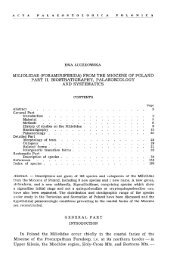The skull of Velociraptor - Acta Palaeontologica Polonica
The skull of Velociraptor - Acta Palaeontologica Polonica
The skull of Velociraptor - Acta Palaeontologica Polonica
You also want an ePaper? Increase the reach of your titles
YUMPU automatically turns print PDFs into web optimized ePapers that Google loves.
196 Skull <strong>of</strong> <strong>Velociraptor</strong>: BARSBOLD & OSMOLSKA<br />
Maxilla. - <strong>The</strong> lateral body <strong>of</strong> the maxilla has a low triangular outline. <strong>The</strong> nasal process <strong>of</strong> the<br />
maxilla is shorter than the jugal process. Along the alveolar margin, there is a row <strong>of</strong> small<br />
neuro-vascular foramina, above which extends a low, longitudinal ridge. <strong>The</strong> antorbital fossa is<br />
weakly delimited. It occupies almost two-thirds <strong>of</strong> the ventral length <strong>of</strong> the maxilla and the internal<br />
antorbital fenestra takes up about a third <strong>of</strong> that length. <strong>The</strong> rostral half <strong>of</strong> the fossa is shallow<br />
lateromedially and bears a small, teardrop-shaped maxillary fenestra. This fenestra is located half-<br />
way between the antorbital fenestra and the rostral margin <strong>of</strong> the antorbital fossa, and it leads into the<br />
maxillary sinus. Close to the rostral margin <strong>of</strong> the antorbital fossa, two small, rostrally directed open-<br />
ings (probably homologous to the promaxillary fenestra) penetrate the bone to enter the promaxillary<br />
sinus. This double promaxillary fenestra has been only noticed in GIN 100125, while in AMNH 65 15<br />
(holotype), and possibly also in PIN 3 14318, the promaxillary fenestra is slit-like.<br />
<strong>The</strong> maxillary recesses are exposed medially in ZPAL MgD-U97 (Figs 7E, 8A). As preserved,<br />
they resemble the structures illustrated by Witmer (1997a: fig. 30) in Albertosaurus, with well pro-<br />
nouncedpila postantralis, antrum maxillaris, and several recessipneumatici interalveolares; the re-<br />
gion <strong>of</strong> the promaxillary recess is poorly preserved. Owing to the damage <strong>of</strong> the rostralmost region <strong>of</strong><br />
the maxilla in ZPAL MgD-LJ97, it cannot be stated whether a vestibular bulla was present in<br />
<strong>Velociraptor</strong>. <strong>The</strong> left palatal shelf <strong>of</strong> the maxilla is partly preserved in ZPAL MgD-U97, its rostral<br />
portion lacking. It is moderately wide rostrally (at least 7 mm), and has a smooth, upturned medial<br />
border. As preserved, a part <strong>of</strong> this border contacts the vomer along the region rostral to pila<br />
interfenestralis. <strong>The</strong> shelf is inclined dorsomedially-ventrolaterally. This inclination gradually de-<br />
creases rostrally, and the shelf was probably almost horizontal at the contact with the premaxilla.<br />
Caudally, the palatal shelf underlies the medial surface <strong>of</strong> the jugal, close to the contact <strong>of</strong> the latter<br />
with the lacrimal shaft. Rostra1 to the lacrimal the medial border <strong>of</strong> the palatal shelf is in contact with<br />
the palatine. However, this contact is located more caudally than that <strong>of</strong> Albertosaurus (Witmer<br />
1997a: fig. 30d). <strong>The</strong> position <strong>of</strong> the last maxillary tooth is opposite the mid-length <strong>of</strong> the internal<br />
antorbital fenestra.<br />
Nasal. -<strong>The</strong> nasal is L-shaped in cross section and its dorsal portion is very narrow along more than<br />
its rostral half. In the rostral portion <strong>of</strong> the snout, the dorsal surfaces <strong>of</strong> each nasal incline slightly me-<br />
dially to produce a groove along the internasal contact. Judging from a vertical displacement along<br />
the internasal suture visible in the holotype, as well as in all other specimens at our disposal, this con-<br />
tact was loose. <strong>The</strong> caudalmost portion <strong>of</strong> the nasal is broken <strong>of</strong>f in all our specimens, but the exten-<br />
sive caudal extent <strong>of</strong> this bone is evidenced by the presence <strong>of</strong> the longitudinally ridged dorsal sur-<br />
face on the rostralmost portion <strong>of</strong> the frontal in PIN 314318 (see below). Approximately from the<br />
fourth maxillary tooth position to the end <strong>of</strong> the maxillary fenestra, the nasal contacts the maxilla and<br />
this contact looks loose in the specimens at our disposal, as well as in the holotype. Contrary to that,<br />
the contact between the nasal and the maxillary process <strong>of</strong> the premaxilla seems more firm. Along its<br />
caudal third, the nasal contacts the lacrimal laterally. <strong>The</strong> nasal deepens rostrally and is the deepest<br />
behind the caudal boundary <strong>of</strong> the narial opening, producing a distinct elevation <strong>of</strong> the snout pr<strong>of</strong>ile<br />
above the nares. <strong>The</strong> outer surface <strong>of</strong> the nasal is covered by irregularly spaced, small foramina.<br />
Kirkland et al. (1993) drew attention to differences in shapes <strong>of</strong> the premaxillae in the<br />
dromaeosaurids, expressed as the length-to-depth ratio <strong>of</strong> the main body <strong>of</strong> the pre-<br />
maxilla. This index is the highest in <strong>Velociraptor</strong>: 164 in the holotype and 170 in GIN<br />
100125, while it is much lower in all other dromaeosaurids: 86 in Dromaeosaurus, about<br />
90 in Deinonychus, and 101 in Utahraptor. Except in <strong>Velociraptor</strong>, the maxillary process<br />
is not completely preserved in any dromaeosaurid. In Deinonychus this process is not<br />
complete (Ostrom 1969b), and has been reconstructed as not extending beyond the cau-<br />
dal border <strong>of</strong> the external naris. On the illustrations <strong>of</strong> the holotype <strong>of</strong> V mongoliensis<br />
<strong>skull</strong> in Osborn's (1924) and Sues' (1977a) papers, this process is short and ends just be-<br />
hind the naris, but in GIN 100125 and 100124 it extends much farther caudally. This re-<br />
gion <strong>of</strong> the <strong>skull</strong> is not well preserved in the holotype and its interpretation by these au-

















